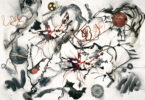At the Blue Mountain Gallery is the Connecticut State University MFA Thesis Exhibition 2015. This year, eight graduate students present their work.
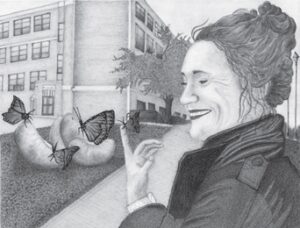
Kanika Khurana
Kanika Khurana, born in Delhi, India came to study at WCSU in 2013. Her use of traditional materials as well as digital in her project, “Metta” which means loving kindness, is demonstrated in the work where a joyful woman makes contact with blue butterflies breaking free from their large scale cocoons. This is an art work of discovery, as if Khurana might’ve been a butterfly opening her wings to a new culture. The woman in the painting is smiling at witnessing the birth of these oversized butterflies as if it was an everyday occurrence. And in this world of benevolence she creates—on the lawn in front of a building that could be the university—flight and beauty are born. The palette consists of muted mid tone colors, drawn with a soft, hoary look of colored pencils giving the images depth and texture that appears other worldly. The face, hair and coat of the woman on the right side is featured prominently, and creates a balanced, harmonious composition between the human and the natural world. This piece is a skilled rendering of Khurana’s intention to celebrate that loving kindness in her art.
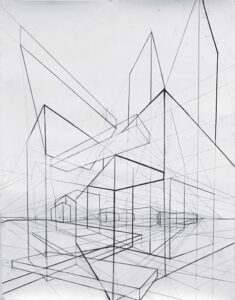
Kerri Gaudelli
Kerri Gaudelli combines a minimalist palette with the complexities of science, perspective, and our place in the universe. In stark contrast to the other works in the exhibit, Gaudelli limits herself to line only as if she were inventing a new lexicon; a mysterious calligraphy based on philosophy, and existentialism. At the top of the piece titled “Coma Berenices,” lines soar to an open space reaching beyond the linear confluence of black and gray cables that meet, intersect and pass one another. It makes me question if we are all traveling in the same way in our angular, wired world. What would happen if we stopped somewhere in one of the overlapping points, or at the spot where she placed a floating, yellow rectangle in the distance, that is a respite in this thought provoking work?
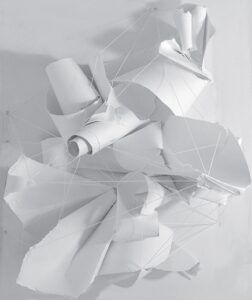
Stacey Kolbig
Stacy Kolbig works with intersecting lines, but in three dimensions with thread and paper. In her work, titled “Tie That Binds #2,” torn shards of paper are rolled, folded, and twisted to create a synthesis of line and form that demonstrates a strong sculptural sensibility. Kolbig’s choice to use something as ephemeral as paper and thread implies that what is bound, or locked up, is also fragile by the very nature of it being secreted. What keeps us shackled is almost always in our mind and perhaps Kolbig is showing us that we can break free with one good push. I admire the shapes and forms in this work, as it tries to unleash what might be holding it back. I look forward to seeing more of her art in other media.
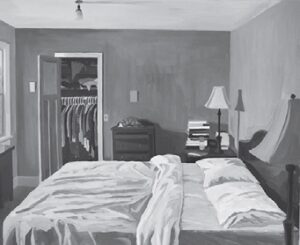
Colleen McGuire
Colleen McGuire’s piece called “The Bedroom” harkens back to Edward Hopper in mood and style. I look into this room and want to know who sleeps there. It appears to be a bedroom that is lived in, with a tower of books on the night stand, an overstuffed closet, and casually made bed. Perhaps a long time married couple lives there, or not to assume the obvious, maybe a single person who is an avid reader. The room elicits two emotions: a calm and ordered beauty in its pale colors, in the soft folds of the blanket, sheets and pillows which I want to touch. Is the bed still warm? I take in the texture of the paint technique in the shaded areas of the fabric. The room also evokes the loneliness of Hopper, yet it doesn’t just leave us with that. The sun, in a sliver of yellow from the window on the left side offers the possibility of a new day.

Jill Harrington Nichols
We enter an entirely different mood when we step into Jill Harrington Nichols piece, “Point of Departure” and into what might be the port window of a boat. Inside this space is a rectangular window that looks out onto a chunk of a concrete dock on the left and another tower shaped dock on the right. What is striking in this work are the bold, abstracted shapes that allude to a painting within a painting and of a landscape in the distance. I admire the dark blue that acts as a frame far from the scene of the window. The painting in this area moves from almost black to hints of blended light on the left side of the piece. This creates drama and power from the walls inside to the choppy sea outside. The arrangement of elements of the geometric hulk on the inside of the picture frame is perpendicular to the orange dock and merges vertically in the water against a faded horizon line. This makes for a unique, poised point of view and a well-crafted style of painting.
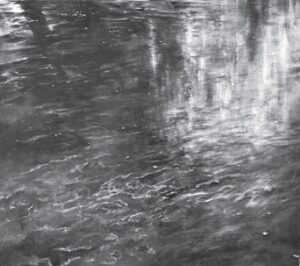
Peri Pfenninger
Peri Pfenninger’s “Fallen Memories” is not only about the mystery and ever changing nature of water, but also about paint and what it can do when it is in the right hands; and Pfenninger uses those artist’s hands well. I am mesmerized when I look at this work with the shimmering light of the blue green water, and the subtle drops of color in the fallen leaves scattered across the darker part of the painting. At the top left is a shaft of light that illuminates the rushing water in contrast to leaves of red and gold. There are both calm and swirling eddies that allow chiaroscuro to create beautiful contrasts throughout. I am impressed by this engaging work, and even if Pfenninger’s art is braided with loss, there is a reverence for life and an acknowledgement of the changes life brings just like the mutability of water. This work seeks consolation, as we all do when we make art, and it is offered in this painting.
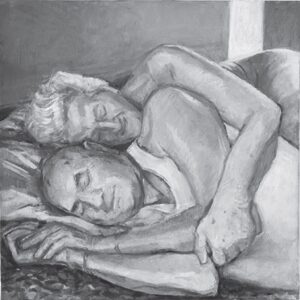
Abbie Rabinowitz
Abbie Rabinowitz paints a subject that we don’t see much; the intimate portrait of an older couple embracing one another in sleep. My immediate reaction to this work was palpable as if I knew these people who were taking a midday nap, in a long marriage, each offering comfort. I wanted to be the woman embracing that man and with that connection. Rabinowitz brings us back to earth with these two comely, light-filled bodies. I am attracted to the manner in which she paints the skin tones, with whites and off whites, the angled strokes, and the detail of the age marks on the woman’s hand in the front. This work is an affirmation of being human, of love, of touching and being moored to a longtime lover. My hope is that Rabinowitz will continue many of these intimate stories.
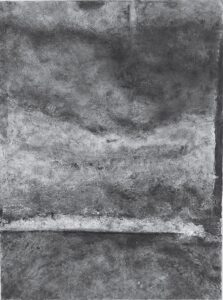
Corinne Speidel
Corinne Speidel honors the Wabi Sabi philosophy which represents the Japanese aesthetic centered on the acceptance of transience and imperfection which come from Buddhist teachings. Spiedel creates surfaces that appear aged and worn, filled with textures achieved through her handmade papers. This work could be any number of surfaces; a sidewalk, the edifice of a crumbling building, a disintegrating road. It could also come from the natural world, from the scabrous skins of rock substratum or the forest floor. She makes a connection visually between the natural world and the man made and lets us wonder and wander in her elegant, abstractions.
In this show, I am impressed overall with the quality of work, of these featured artists. There’s not only skill in their work but they also present to us our humanity—how we are connected to one another and to nature and how critical that bond is to our future. My hope is that in works to come these artists will continue to go deeper as they develop and grow, and I look forward to what they will have to say to us. We better be ready to listen and to look.
“Five Artists” Master of Fine Arts Exhibition, Blue Mountain Gallery, 530 West 57th St., New York, NY




